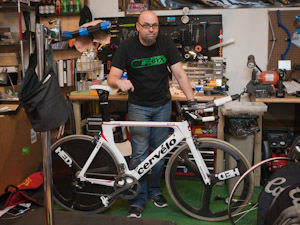
We’re spending the day at Mark Purdy’s shop, Ifixbyx, to liveblog a P3c Di2 build. Like the P4 build we did a while back, the P3c isn’t made for Di2, so it’ll require some creativity from Mark to get things routed nice and clean. Feel free to write in with questions here or on Twitter and we’ll answer them through the course of the day.
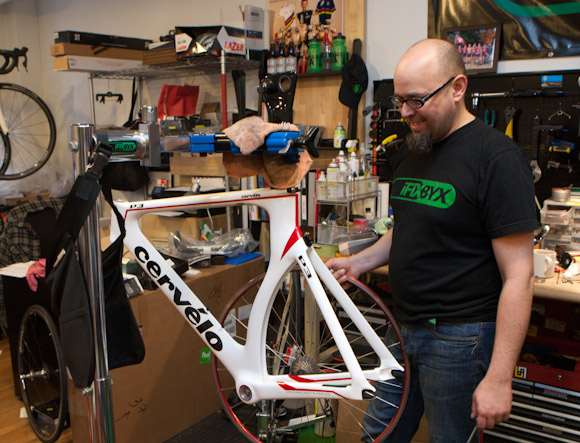
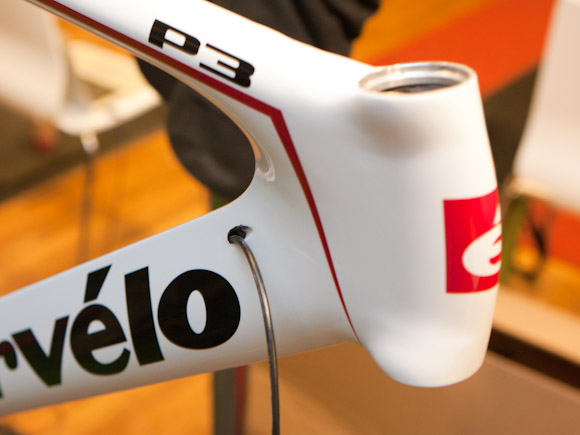
Mark drilled out the cable hole before I arrived. It’s an aluminum insert, so no carbon was harmed in the making of this movie.
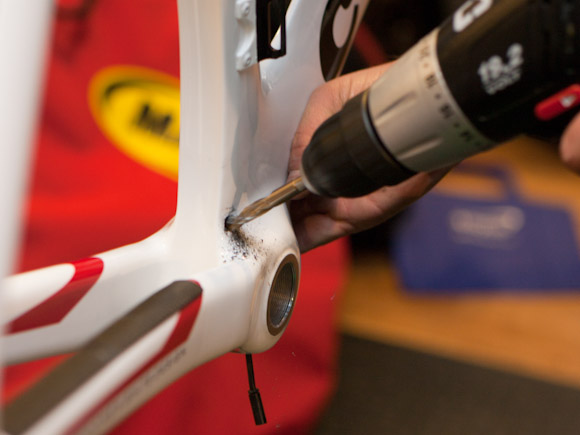
Well, that didn’t take long. Mark’s enlarging this hole so 2 cables can come through.
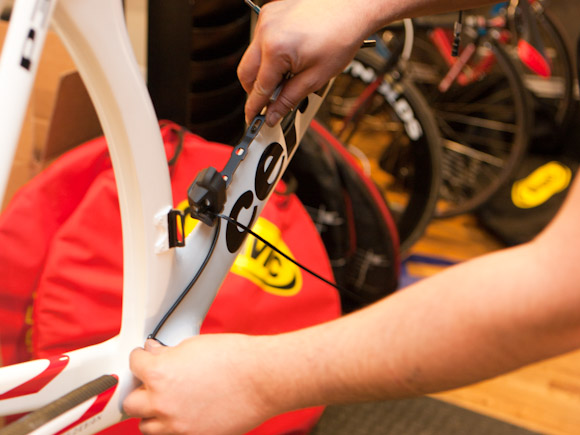
The battery will be mounted on the water bottle bosses and the cable will run through the hole Mark just enlarged.
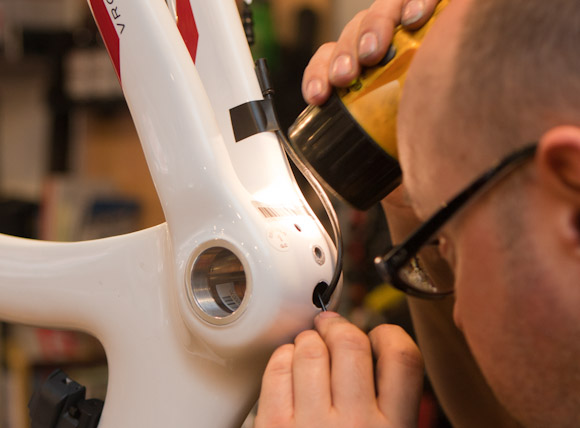
Mark’s going to be fishing for wires for a while.
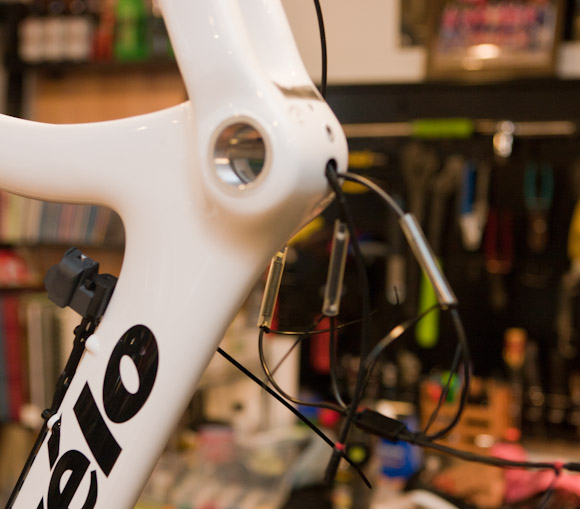
This whole mess will be shoved inside and live in the downtube.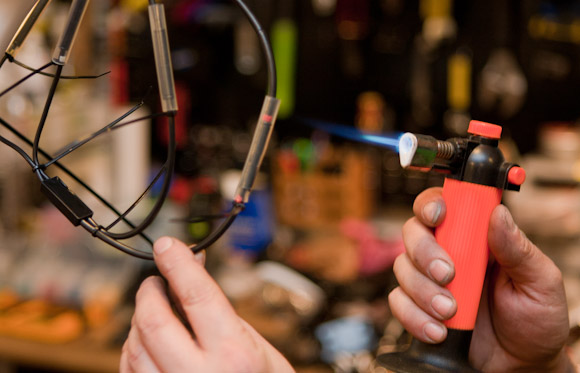
Heat shrink!
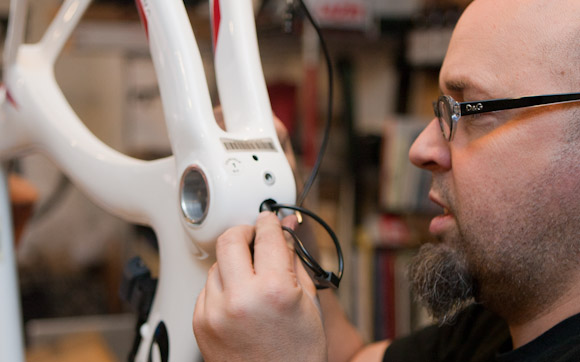
The cable splits inside, one end goes up the downtube and the other end goes up the seattube. Getting it to split off just right inside is a pain in the ass.
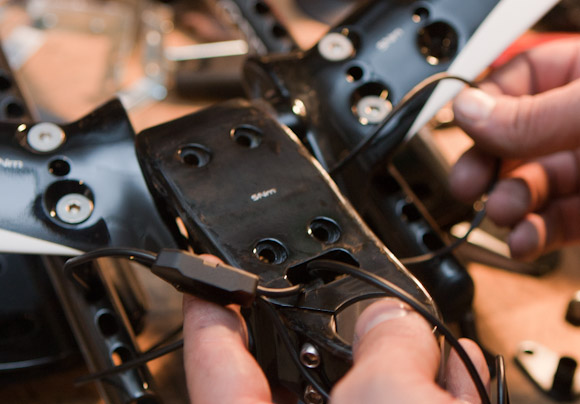
The frame’s wired but the battle’s only half won. These Shimano Pro bars have an integrated stem. The shift wires will run down the arms and into the integrated stem, then down and out.
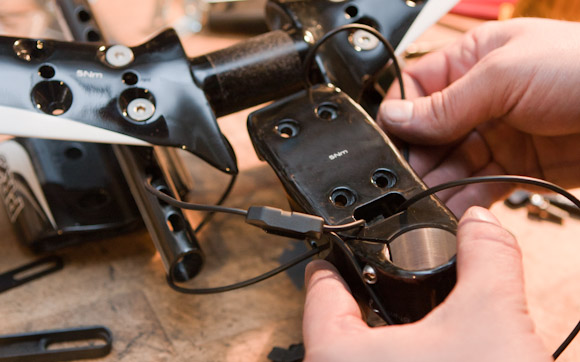
A clearer shot of that cable routing.
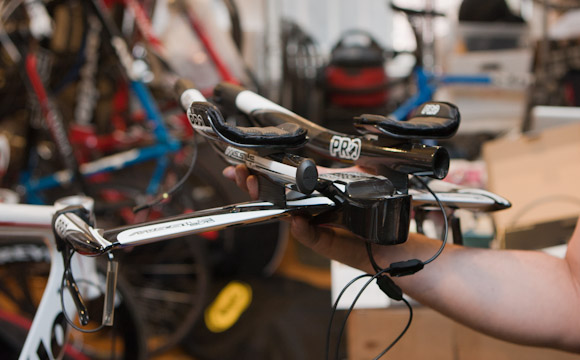
Two sets of shifters per side and brake cables too. Lots of stuff to route.
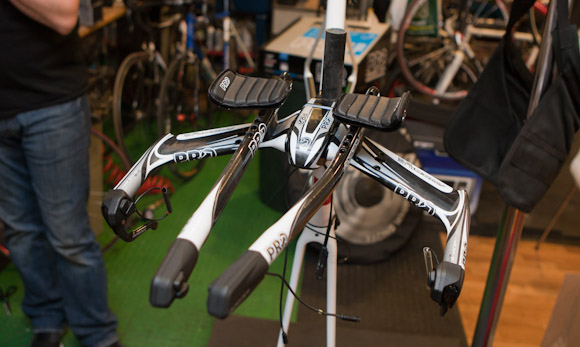
Pretty snazzy set of bars. The worst is over, the rest is pretty much a normal bike build.
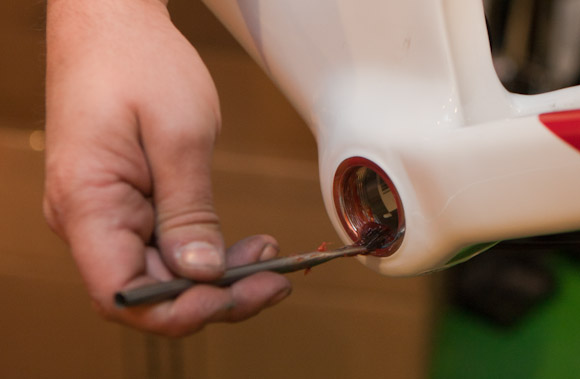
Mark greases the threads of the BB and the shell. He doesn’t believe in using plumber’s tape or Locktite. Plumber’s tape can tear and bunch up, Locktite can creak and chirp.
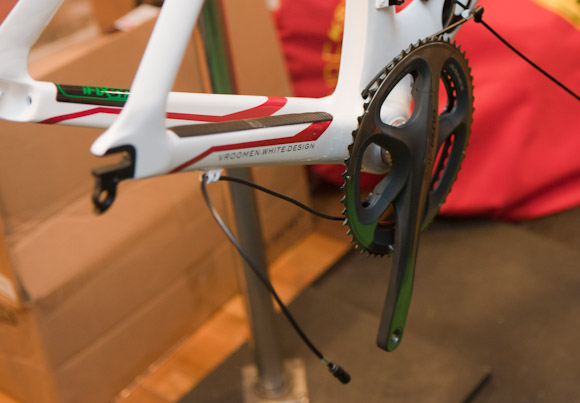
What, no power meter on a bike this swanky? (Mark made me type that)
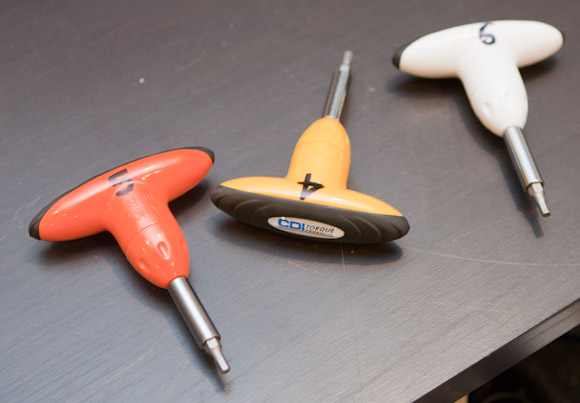
New toys: preset 4-5-6 Nm torque wrenches, $30 each, great for a bike fitter who’d make a lot of changes.
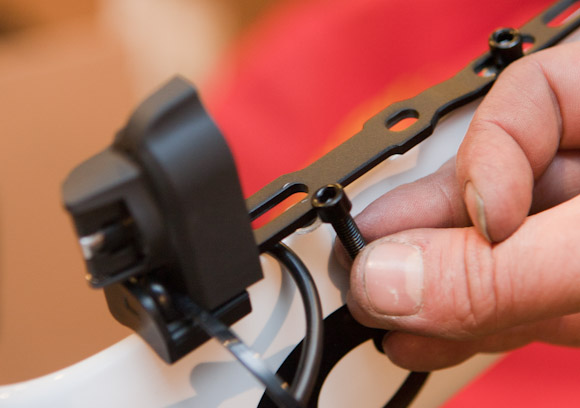
Water bottle bosses usually sit higher up on the downtube, leaving more room for the battery. The second bolt head is going to interfere with the battery, so Mark will have to get a countersunk bolt and countersink the mount so the battery can slide in.
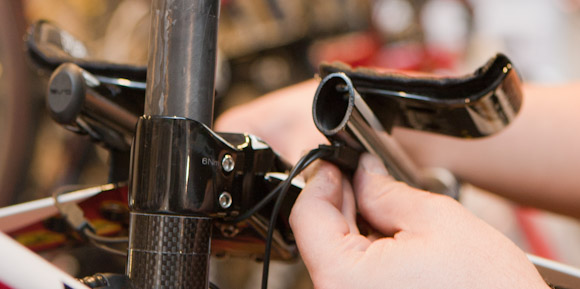
Wires from the bar end shifters exit out the back, will meet up with handgrip cables and ‘Junction Box A’ (the little controller that lets you tweak the shifting) under the stem.
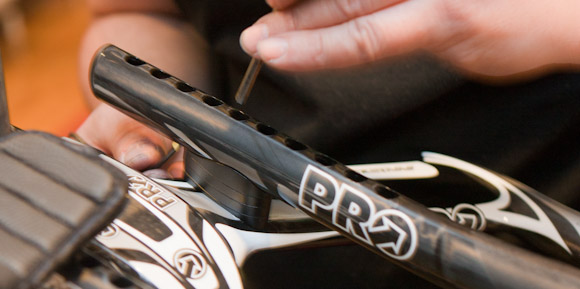
This is a pretty colossal pain in the ass. There’s a free floating nut plate inside the extension that the armrest will bolt into. Mark’s gotta get it in position and make sure it doesn’t pinch the wire that’s inside.
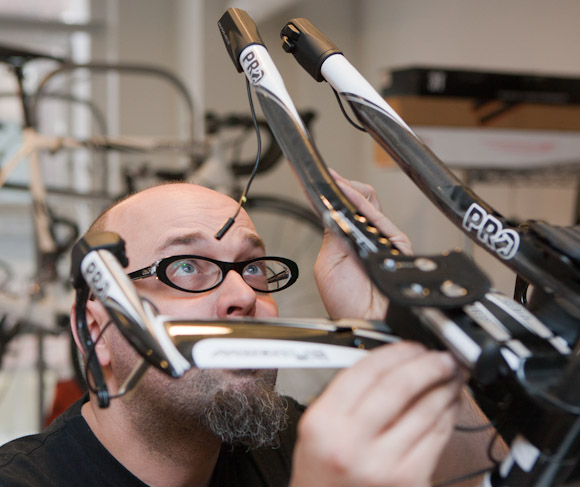
Now Mark’s gotta fish the wire out the front so he can plug it into the shifter, then shove the whole mess back in the extension.
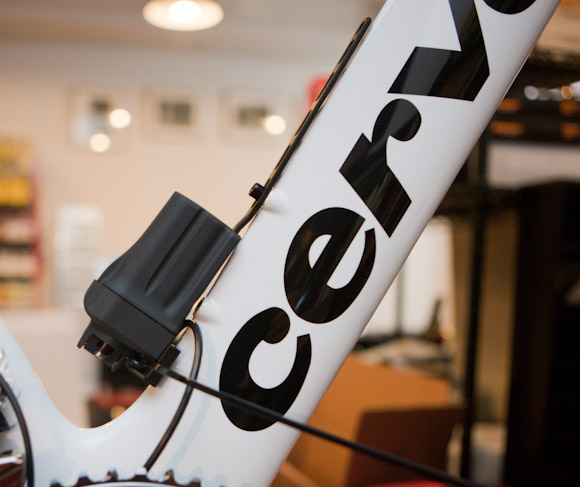
A better view of the battery mount problem. Note how the lower bolt interferes with the battery. Mark will use an adapter so that a bottle cage can be mounted, higher up on the downtube.
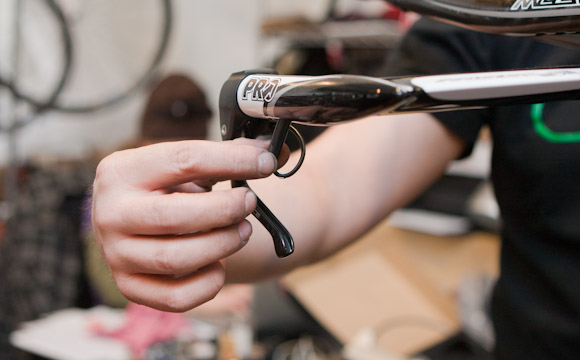
The shifter has a short cable and a plug, which meets up with the cable routed from the other end. All this will go into the base bar.
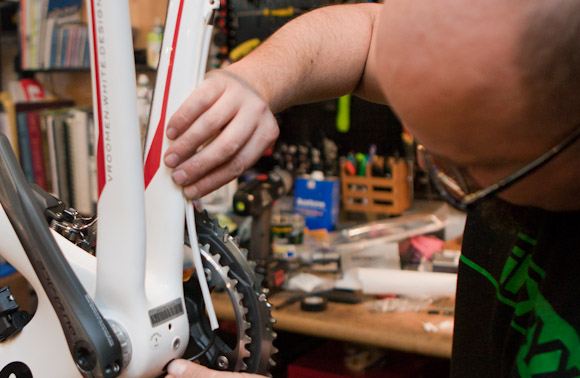
Wiring tape covers this run of cable that sits outside the frame. It comes in white, grey, and black.
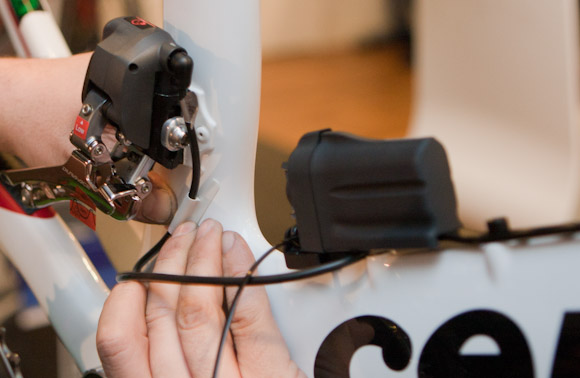
Cleaning up the front derailer and battery wiring.
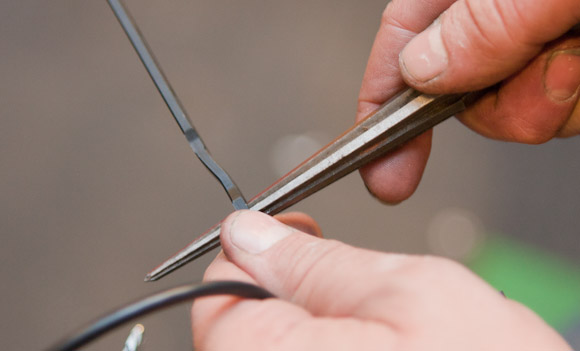
Countersinking the battery mount.
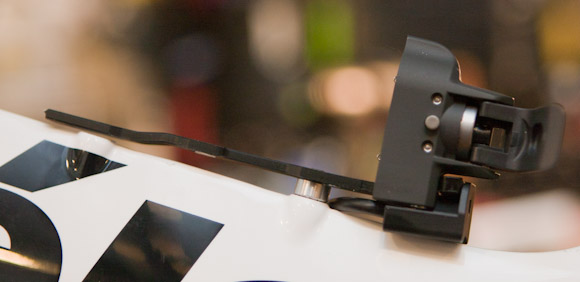
The battery mount’s turning out to be a bigger pain. It needed a spacer underneath so the wiring could clear.
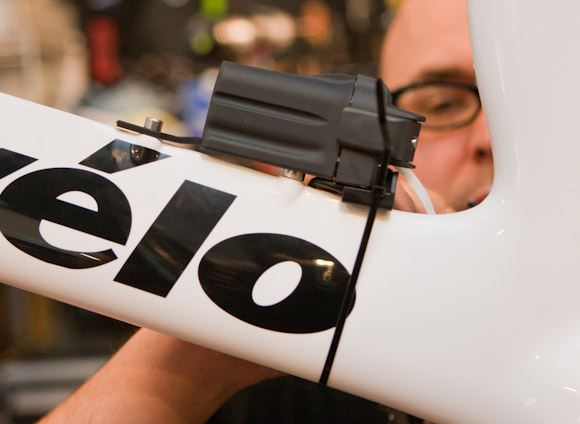
Done. A ziptie keeps the battery snug.
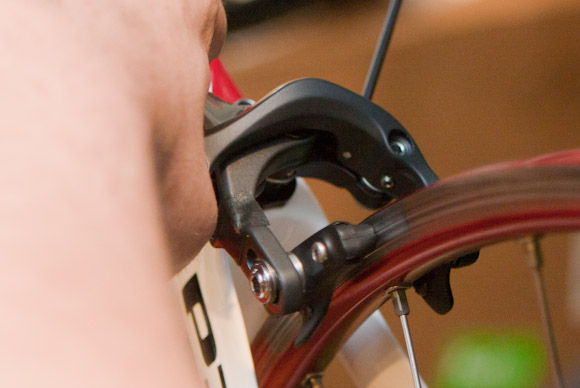
A Mavic Helium stands in so Mark can set the brake pads. Mark doesn’t toe in unless there’s a specific problem reported, and even then he says road brake arms are so rigid they’re rarely the source of the problem.
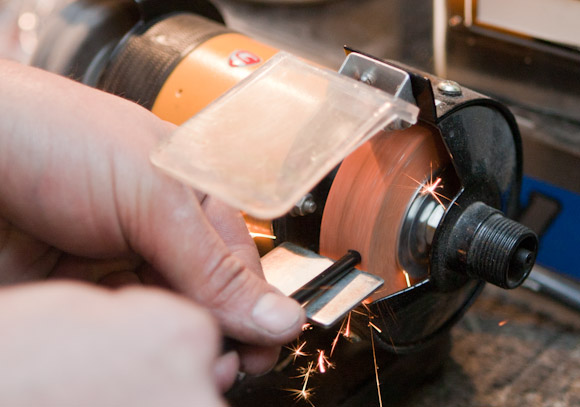
Grinding the brake housing nice and square on the cut ensures that the housing is seated properly right from the start.
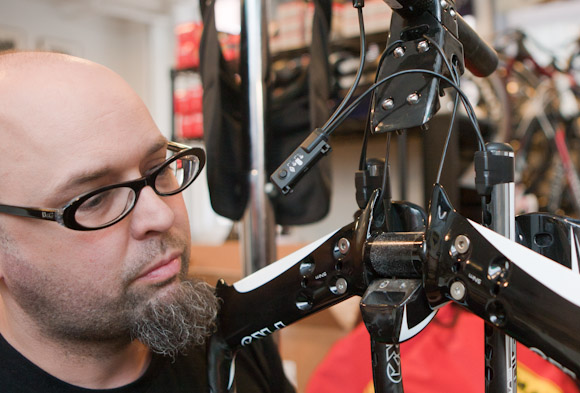
Mark opens up the stem again to route brake housing. These bars are abusive. The housing runs through the wings, into the stem, and out the bottom near the steerer tube.
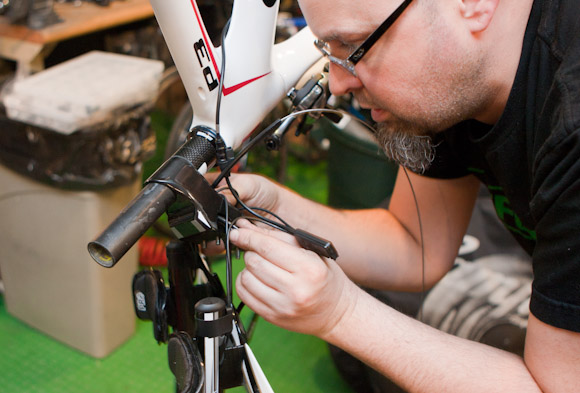
Shoving everything back in and cinching it up. If this wasn’t a Di2 build there’d only be two pieces of housing running through the stem.
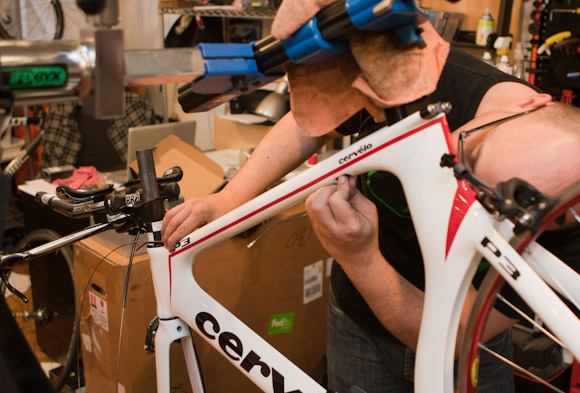
With all those cables and wires the front brake will have to exit through the wing, not the stem. Mark works on fishing the rear brake cable out of the frame.
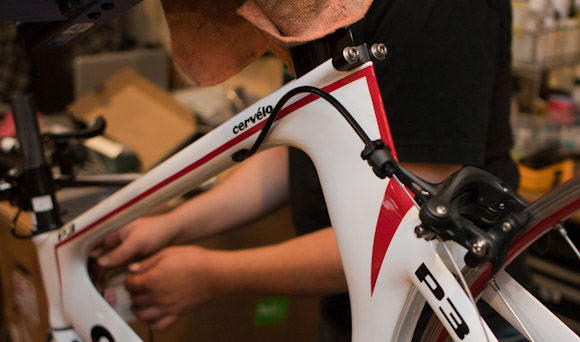
Rear brake done. Mark was surprised at how good the brake felt considering all the twists and turns the housing had to make. If there had been more drag he might’ve considered using Nokon housing, which he prefers for braking but not shifting.
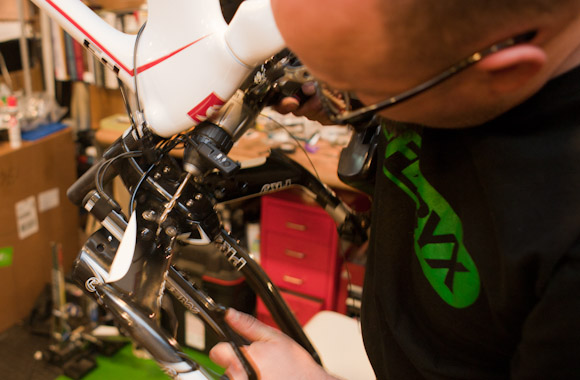
Mark drills out an existing hole in the wing at an angle to route the front brake housing.
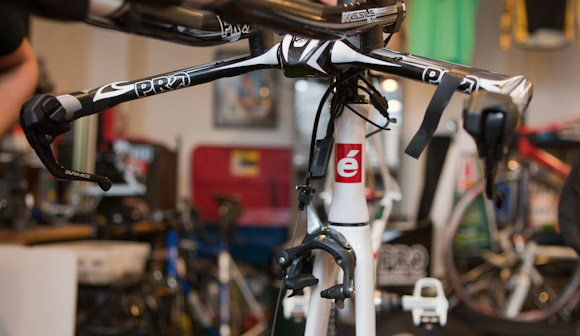
Front brake done, nice and clean.
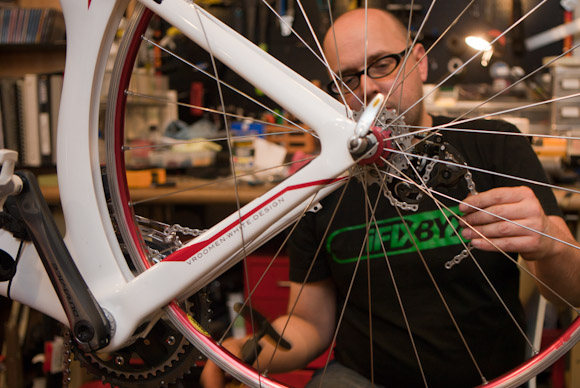
After all this mounting a chain seems so mundane. To set chain length, Mark puts the chain on the small ring/small cog, and adjusts the length so the chain clears the cage. He prefers this to the ‘big/big/bypass the derailer’ method because you won’t end up with a too short chain should you switch to a cassette with a bigger granny.
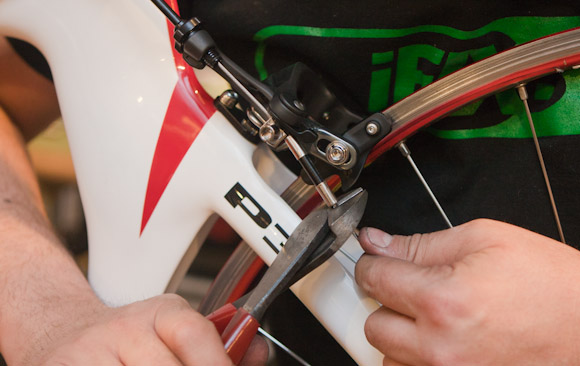
Mark uses this piece of housing to ensure that all his cables are cut to the same length.
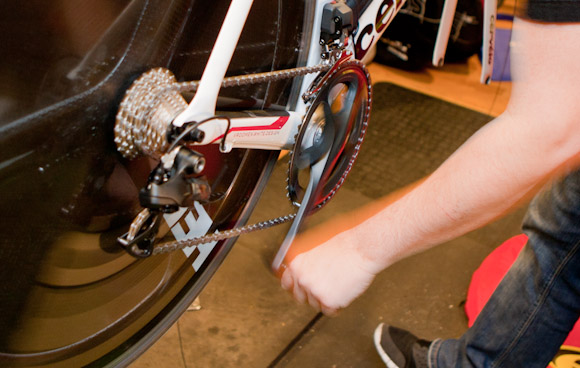
Checking the shifting with the real wheel in place. If this were a cabled setup Mark would err on the side of having slightly more tension, so things will settle into the sweet spot over time.
Lunch break!
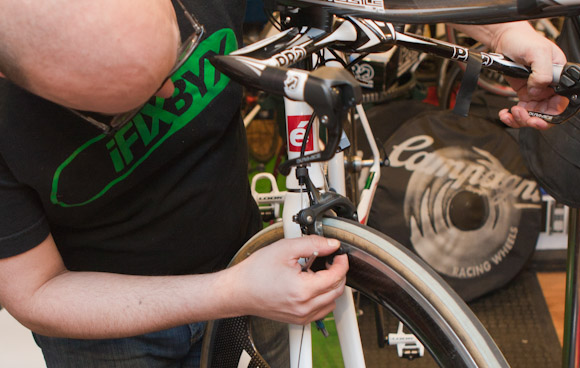
Setting the front brake.
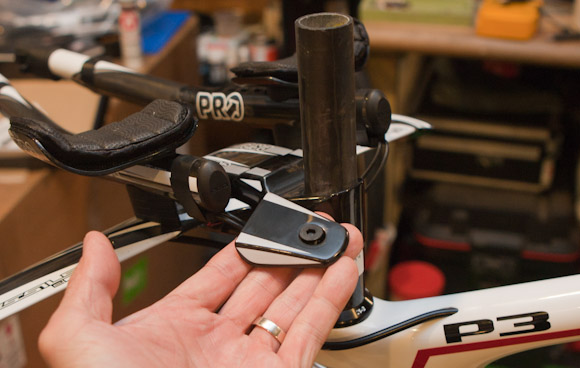
This crazy angled top cap means there won’t be any extra steerer above the stem. Mark won’t cut this steerer until his client comes in and gets fitted.
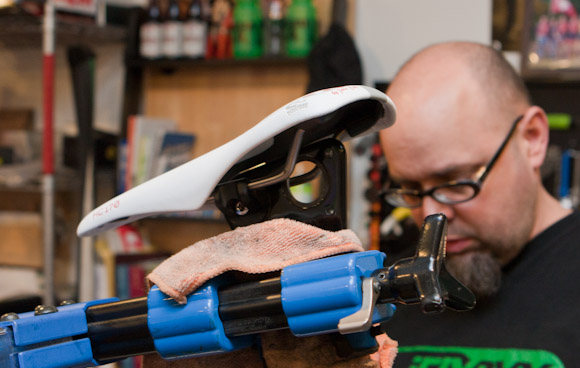
On goes the saddle. Mark isn’t opposed to greasing the rails, but he doesn’t do it.
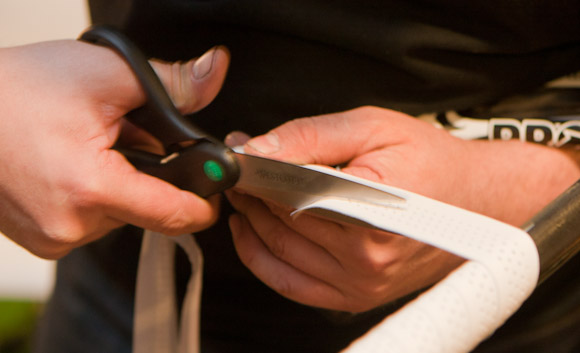
Finishing off the bar wrap with an angled cut. When taping up with electrical tape, pull hard for a couple of wraps, then finish with minimal tension. This reduces the tape’s tendency to unwind.
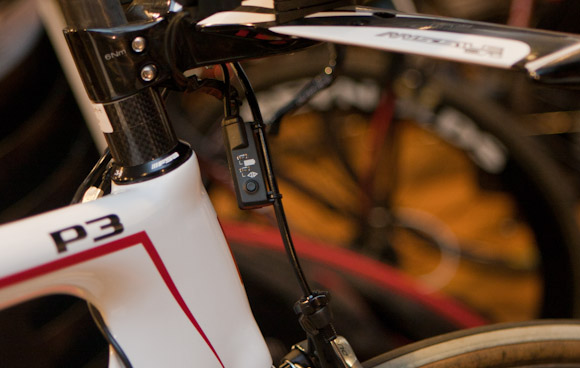
Front end wiring cleaned up, that’s the infamous ‘Junction Box A’.
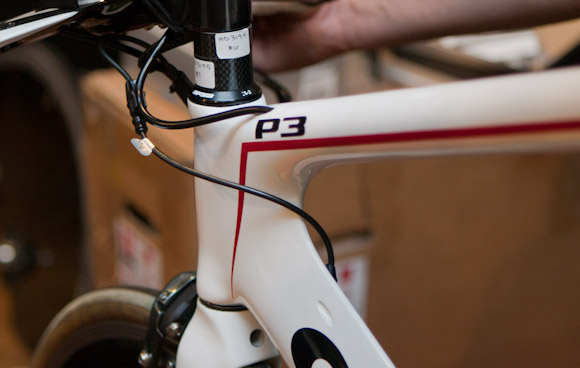
That single wire handles all shift duties.
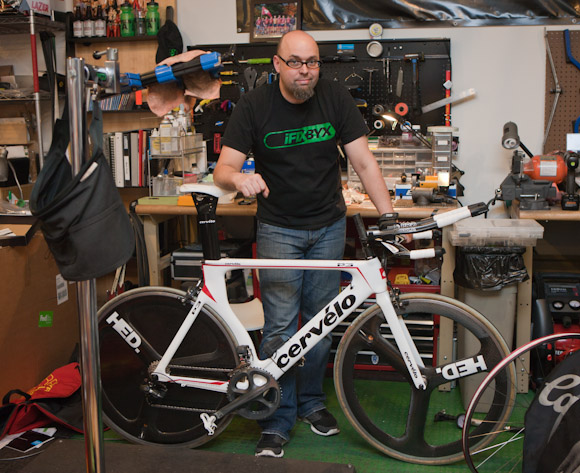
And we’re done, or as done as Mark can be without the proud new owner on the bike. Keep sending in questions and I’ll pester Mark to address them. Thanks for following along!

Sweet Jeebus! you’ve got to have a steady hand and plums the size of grapefruit to be willing to drill out a frame like that.
Looks like risky business. Is there anything Purdy CAN’T do?
Now available from Vivid Video, “The Hole Mark Just Enlarged.”
DRILL BABY DRILL
Does this mean Mark won’t be getting to my bike today?
what are the advantages of having electronic shifting on a TT bike? Does the bike belong to an ironman triathlete? It just doesn’t seem worth it for the expense for the relatively short TTs in the area.
Actually the shorter and harder the TT, the more advantageous faster more precise shifting probably is. Especially on a more technical or variable course. Think about it, seconds count.
– idot
who’s the manufacturer on those? Do they take different bits? Me likie!
Torque wrenches are made by Williams. It says ‘CDI Torque Products’ on the handle.
Other advantages of Di2 on a TT bike: having shifters on the handgrips and the extensions, cleaner/more aero cable routing, better shifting since cable routing on TT bikes can be really tortured.
Where does the Gruber Assist go?
how much are you paying for that 1 second gain? $3000?
If you are paying for it, you can afford it. If you are given it, you are PRO. If you are complaining about the cost, it’s not for you.
And yes, the torque wrenches take different bits.
I dig those torque wrenches. I hate electric shifting on bikes even though I “can afford it”.
e-shifting on tt bikes is great for triathletes since they can barely ride as it is.
wheeeee!
http://www.youtube.com/watch?v=NRKajY5GlyI
All that cost for 1 second of gain? Pete Cannell could make you faster for much less!
Mark uses this piece of housing to ensure that all his cables are cut to the same length.
This is the level of detail I aspire to when working on my own rigs. Does Mark build frames or have frame building knowledge? If not, is that something he’s considering?
Can Mark store any small parts or tools in his goattee?
What kind of wire tape is Mark using? is that straight up electrical tape, or something contoured? looks a bit more formed than regular tape.
The tape is a Shimano item specifically for Di2 wiring, it’s contoured with a well for the wire. He’ll use it for wired computers as well.
Isn’t the cable that extends out a little on the long side? I thought it should be around 30mm.
Why doesn’t Mark grease his rails?
Mark doesn’t grease the rails because that interface is rarely a cause of creaking, and grease just makes slippage more likely.
Where does he install the kickstand?
Does Mark have a closet full of IFIXBYX shirts ala Ronald McDonald?
Is Chad doing the bike fit?
Serious question, from the picture those bars look too long to be aero, will you be able to cut the bars if needed?
Where’s the seat tube-mounted motor?
Thanks Andy! Just found the Shimano wire tape online and purchased it.
The aerobar extensions? They have lots of mounting holes, so you just mount them further back.
And there’s no issue with the internal wiring?
How much more labor/time does it take to make modifications to a bike if you have DI2 installed? For instance, you want to change out bars, or you get in a crash and one of the levers cracks, or a wire gets frayed, etc.
I ask because Mark was putting some heat shrink tubing on some of the connectors, which means labor and care is required to de-couple the wiring (whereas with traditional cabled systems, you can just take a side cutter to the cable and start over).
So I guess my question is – DI2 is clearly a bitch to install, is it also a bitch to service and modify? I get the feeling it’s bitches all the way down.
We’re expecting minutes off the next local TT with that rig
Can we get some additional shots of Mark’s workspace?
More shots of Mark’s space:
https://nyvelocity.com/content/equipment/2011/speedplay-rebuild-mark-purdy
I’ll get Mark to address the other questions.
You forgot to install the Westwood Velo dude on top of that thing
Clearly whoever owns this bike has a very tiny dick
That’s a clean build sir.
Purdy rocks.
Who the hell has room for a TT bike inside of a tiny NYC apartment?
Not everyone has had a good experience with Purdy working on their bike. And I’ll just leave it at that.
4th place, CRCA C Race
II
II
II
II
\ /
\ /
\/
absolutely no, zero, none, zilch, nobody will have 100% approval rating.
I just got my Cannondale Hi Mod back from them. the di2 battery is now in the post. it is really cool.
for 500 bucks you get; touch up paint since they removed my cable stops, a new larger battery that last longer,a specific charger, and the holes drilled by a major carbon bike mfg.
the battery and the charger alone from shimano cost like 200 bucks. it is a no brainer if you are running Di2.
the internal wire kit is an additional 250 if you do not have one
Not everyone has had a good experience in the Kabuki Room at Cheetah’s, and I’ll just leave it at that.
4th place in a C race to Mengoni
Dude that’s his business you’re negatively reviewing for no reason. Purdy is a NYC fixture especially around the NYVC/CRCA parts. Negativity thrown his way will not be well-received in this forum. “And I’ll just leave it at that.”
I would not give a negative review “for no reason.” The work done on my bike was not satisfactory (especially considering all the hype) and I would not go back. I didn’t know that we all have to idolize Purdy.
By the way, he is the only mechanic who has ever put a sticker on my bike advertising his business without asking me and it wasn’t a sticker that came off easily.
maybe your bike was a piece of shit and he did the best he could.
did your issue get fixed by someone else?
between the frame, components, Hed power tap wheel set, etc. cost about 6 to 7k. I replaced all his work myself (cables, bottom bracket cups, etc.) except for one thing I could not do myself.
i don’t get it, but oh well.
What was wrong that you had to re-do everything minus the one thing you couldn’t do? The one thing, was it remove the front wheel? (just guessing)
You expect an answer when you respond like that. Here’s your answer: Fuck you.
I love being right.
NGB, your life is the sum of a remainder of an unbalanced equation inherent to the programming of the matrix. You are the eventuality of an anomaly, which despite Purdy’s sincerest efforts he has been unable to eliminate from what is otherwise a harmony of mathematical precision. While it remains a burden assiduously avoided, it is not unexpected, and thus not beyond a measure of control. Which has led you, inexorably, here.
What Mr. Pill said…
…settle down! No need for fisticuffs at my expense. N-G-B, I’m sorry that you were not satisfied with the work you received from me. I am obviously not in the habit of trying to piss off my clients. I hope that you accept your situation was an anomaly and not typical. That being said, I have no realistic aspiration of making every client totally thrilled with every single aspect of the services I offer. In other words, you can’t please all the people all the time. And that’s how I sleep at night, like a baby.
Entropy.
NGB to Mengoni
Since NGB never listed a reason just that he was un-happy I will have to conclude he is just un-happy and nothing Purdy did or could do would of helped his un-happiness.
If a reason was listed it would help anyone trying to fix the problem or at least avoid it in some way.
I’m still going with my front wheel guess.
WCR, err, I mean ahole, perhaps you can’t read. I noted two things that were not satisfactory that I redid myself, the cables (and the housing) and the bottom brackets cups. In addition, a repaired shifter did not work anywhere as well as the numerous shifters I have had rebuilt by QBP where Piermont sends out shifters to be rebuilt.
The cable housing system was a more exotic system that I had no experience installing which is the main reason I brought the bike in. I replaced it myself with a standard cable housing system which I have previously installed on my bike myself. I took the shifter off and replaced it with the shifter from my second bike and had the “repaired” shifter rebuilt by QBP (sent from Piermont). The “overhauled” bottom bracket cups still felt gritty afterwards, so I purchased new bottom bracket cups and installed them myself, something I have also done previously on my bike.
You might consider brushing up on your reading skills.
something is very wrong with this chain of events. doesn’t quite add up.
you said the bike was worth $7k.
yet you brought him parts that needed to be rebuilt and installed?
and exotic cable system? huh? ok there’s nokon or yokozuna which is slightly different, but it ain’t friggin’ rocket science.
hmmmm…..
there are two sides to every story, and the truth is somewhere in between.
something smells rotten in the state of denmark.br
Dude, the bike is 6 years old and parts like bottom bracket cups/bearings and housing/cables need to be overhauled or redone. Shifters eventually need to be rebuilt or replaced.
You’re missing at least one alternative housing/cable system which is more unusual than the standard (and by the way, the extremely rigid brake housing from Yokazuna makes for a tricky install with brakes that have weak springs like zero gravity, something I learned when I installed that system).
I’m done discussing this. I have more than adequately explained what I was disatisfied with (Piermont confirmed the shifter needed to be rebuilt and the cable system was not correctly installed).
so you gave him a 6 year old bottom bracket to overhaul and expected it to be like new?
Uh dumbass.
I gave him a 1.5 year old ceramic bottom bracket to clean and put in new ceramic grease and it came back with the drive side (and yes, with the crankset pulled and feeling with my finger) feeling gritty.
I’m not an idot. I do 90% of the work on my bike myself which is more than the vast majority of local racers do.
You could brush up on your reading skills as well. If you had read a few posts back, you would have read that I have previously installed new bottom bracket cups on my bike (so you would have known the cups were not six years old).
I can install new cups. I do not have a bearing puller/press so I cannot remove sealed bearing to clean and relube. But then, you probably don’t know what bearing puller/press is, dumbass.
Guys, lets face it Purdy is a one man show. He’s a great mechanic but busy as hell. He’s probably under a ton of pressure to turn your crap work around super fast and that’s going to lead to inconsistent quality. Nobody is perfect. And he doesn’t seem to be bothered by it, so who cares.
That is a reasonable take (though I doubt Purdy would like to be thought of as inconsistent).
What I won’t accept is the prevailing view here that the work on my bike was fine and I don’t have the competence to recognize that.
WTF is a ‘gritty’ BB? Seriously? I once had a roommate who used to pull his BB every 7 days to ‘grease’ it. He was a dumb ass and I could drop his Cat 3 ass every ride. Dude you’ve too much time on your hands. Purdy is a rock solid mechanic and if you’re that much of a detail geek take the bike to someplace where they’ll worship your 7k spending ass. Other than that shut the f up. It’s a bike, not some precision piece of machinery. Also WTF are you doing spending that much dough on a bike? Zero Gravity brakes? Yeah, those make a lot of sense…clearly Shimano, Campy, SRAM underspend in engineering leaving a bunch of idiots with s CnC machine to ‘perfect’ braking ‘systems.’
even though, honestly I don’t understand 80% of what Andy and Purdy are talking about. After many years of riding and racing, I still find anything beyond the basics of wrench work too difficult. Nice to see such exacting work though by a mechanic I’ve heard a lot of very good things about. Thanks guys.
next time I want to comment on something you said I’ll first back track to find all your posts, create a chronological time line for myself indicating when you replaced each part, when Mark replaced it, and when you had to re-do it yourself. That way I can take it and shove it up your ass along with your gritty bearings.
Not only would I trust Mark with my bike, I would also trust him with many minor surgeries. I’m saving the gender reassignment for the pros though.
NGB, your posts are extremely gritty to me, can you replace them?
I play a mechanic to friends and find my self feeling for gritty, laggy, catchy, grabby, knocking, grinding, or some other feel word and 99% of the time its some grit or grime build up up and around the BB or crank to BB mounting. A good clean up and lube and its all fine. Most are just Jones-ing for and upgrade to ceramic or a whole new crank system at the drop of one excuse.
As for the cables, you know they sell stronger springs right? No instead you replace the whole cable system… ugh.
WTF ? IN New Jersey there is practically a TT every weekend from short 9 min efforts to full on 40Km TT’s and there are plenty of them.
Very well organised and not much difference than driving to race in upstate ny, plenty within 1.5hrs distance,
Cambridge GET SOME ! – You very off topic. Were are making fun of NGB’s inability to lube, not TT’s. TT’s and Jersey don’t need help being lame. NGB does. Okay? Cool.
Only problem i see here is a ” picture ” of him drilling on carbon bikes and parts. Like Cervelo is going to warranty this frame when it cracks!
That issue was discussed in detail with the client prior to assembly. But the reality is that noting I did actually weakened the frame any. The real fear is when/if the frame breaks for any one of the other reasons that Cervelo’s break, then Cervelo will not warranty the frame because it was “altered”. The client is aware of the risks and is willing to take the chance.
There’s nothing some bondo and touch up paint can’t take care of to put back into warranty form. In fact some bondo and a cool Cervelo sticker is all you really need.
Not that I’ve ever done that, heard it from a friend, no it was NGB!
NGB to mengoni.
NGB to ifixbyx!
Good luck getting a warranty out of Cervelo anyway.
Can you do something other than a zip tie? How about a small diameter narrow solid black hard rubber bushing, perhaps 1/4″ long (which would give just the right amount of clearance at the bottom), that’s drilled out to fit the M6 bolt? That zip tie job looks schlocky, like something NGB would rig up since he knows so much about doing his own wrenching.
Elvis had the same problem – it was all the corn.
NGB is Purdy! Purdy is NGB!!! Just like from Ace Ventura, “Laces Out”!
One thing that gets me about the Di2 is with the minimalist approach of the Mavic Mektronic, why did Shimano instead turn the coolness of electronic shifting into a spaghetti system? I’d of expected an improvement on the Mektronic not a cable nightmare.
I used the Mektronic, and it had almost no cables! Now that was cool, but this mess, I’d stay clear.
OK, so Di2 had electronic front derailure as well, props for that but the cost in weight and mess, well not a plus. Then from the looks of it you need a Di2 compatible frame, not one you like to have it setup properly, without drilling holes.
Now to get some electronic dude to get my old Mektronic to work again… still looking. Mavic sent it back and no fix…
… seems to be one simple, unavoidable matter. Di2 functions to the rider so much better than ANY other system out there that it is almost unfair. A lot of effort has been spent here talking about the logistics of the sytem. Everyone is entitled to voice their opinion. But those who speak negetively about it have obviously never ridden it. One 3-hour ride will convince you to start selling children to get it. Never mind the BS details of what I have to do to install it on your bike. When you ride it, you’ll know why. Is there room for improvement? Of course, that’s the fun part of any new concept. But whether you like it now or not, Electronic systems will dominate the peloton in due time.
Cancellara had his mechanics put 7900 back on his bikes.
“Cancellara said: “I prefer manual. You have two possibilities, and (on this team) we have the choice. For me, it’s been okay as it is (manual). Both (Di2 and mechanical) are something nice. Not everyone has the same preferences, and it’s good that we can decide”
he was getting too much interference from the down tube motor
I’m told there are a few reasons why Shimano went with wires:
First, you’re among a minority of people who have fond memories of mektronic. I’ll agree that wireless transmission has made massive improvements in the years since, but from what I’m told, Shimano didn’t want to risk bad reception of their new product based on the bad taste that mektronic left in most people’s mouths. Most people think of mektronic as being a cool idea, but a crap product.
Second, as you said, mektronic only offered electronic shifting for the rear derailleur. Both the shifter and the derailleur took separate batteries, and said batteries required regular replacement (and don’t get me started on having to re-sync the derailleur and shifter in some kind of underground bunker shielded from E.M. interference, working on the stuff was plain ugly). The power requirements of a front derailleur servo motor are surely a good bit higher than a rear derailleur (greater travel per shift / more force required) Using wires allows di2 to use only one rechargeable battery for the whole system. Also, keep in mind the electronics in di2 are quite a bit more complex in regard to automatic front derailleur trim adjustment. This makes the system much friendlier to use, but requires power as well.
Third, they had to leave something for di3. I wouldn’t be surprised to find that subsequent electronic drivetrains go wireless, but remember wireless transmission takes power as well. If Shimano wants to keep the interval of time between recharging batteries as long as it is now, they’ll either need to include a larger(heavier) battery or wait for battery technology to improve (lighter/more power density).
I think there’s a market for smaller/lighter battery packs that require more frequent charging. Maybe a rider could use the big battery for training and every day rides, but switch to the smaller battery for race day to save a little weight. It wouldn’t be much, but if you’re into spending $4500 on a drivetrain, spending $100 on another battery to save a few grams shouldn’t be an issue.
the coolest thing about di2 is you could spend around $2k less on a plain 7900 group, save even more weight, and shift yourself. brilliant!
I said that back in 2000 with Mektronic and until now we have another electronic groupo…
I still think going with wires is a step backwards though.
Say what you want about the cost but If you doubt the utility of Di2 on a TT bike, just watch today’s prolog tt at the Tour of Ramandie.
Highly technical. The guys with Di2 got to shift from the bullhorns and maintained a lot more speed, while the manual guys noticeably slow, take a hand off, reach up and shift from the extensions.
All the top finishers had Di2.
no shifters required…if you think you can TT line up for an Individual or Team Pursuit
now back off!!!
🙂
With over 50 years of professional experience, Aladdin Plumbing Mechanical plumbers mahwah nj provides the high quality plumbing services you deserve!
http://www.aladdinplumbing.com/plumbers-mahwah-nj/